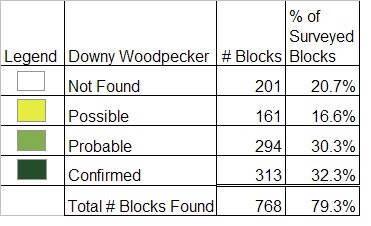Find a Bird - BBA1
Breeding Bird Atlas 1 Species Accounts
Downy Woodpecker
Picoides pubescens
Egg Dates
May 4 to June 21
Number of Broods
one; may re-lay if first attempt fails.

The Downy Woodpecker, named for the soft appearance of its feathers, is a common bird resident throughout the state, and it is familiar to most people. It nests in a wide variety of wooded areas: deciduous or mixed forest, second-growth scrub, orchards, parks, small woodlots, and urban gardens. This woodpecker is the smallest of those in the United States and Canada, yet its penetrating whinny call can be heard a quarter-mile away.
Drumming and drilling, important activities for most woodpeckers during courtship and nesting, are performed by both sexes in this species. Territorial drumming by Downy Woodpeckers can be heard in Massachusetts throughout the winter. When courtship begins in April and May, or sometimes as early as March, the drumming and the shrill whinnying calls increase in frequency and serve to bring the sexes together. A tchick note is also distinctive, sharp, and very brief. Downy Woodpeckers have been observed inspecting trees, apparently to locate the most resonant drumming spot, to which they then return to continue tapping.
Courtship behavior is variable but usually consists of much active chasing and flitting from tree to tree accompanied by loud calls and squeaking, an exaggerated bounding flight, a display of the white spots on the coverts and flight feathers by wing spreading, and elevation of the male’s red patch. Often, two males will contest for attention by pursuing the female until one gains a position facing her with wings spread in a preliminary maneuver. Then the other male flies between them and interrupts the ceremony. At times, there may be a very quiet and inactive competition, with the participants perched on separate trees within sight and sound of each other. They remain completely motionless for minutes at a time until two fly off together, a silent selection somehow having been made. Courtship lasts a week or two, and, once mating has occurred, a somewhat prolonged search for a suitable nest site follows, with the partners attracting each other to chosen locations by tapping or drumming. The pair bond may last several years.
A dead branch or stump is usually chosen for nesting, but occasionally a wooden building attracts them. They will chip a hole through the wood and if not driven away by an irate householder will enter to nest between the inner and outer walls on a joist or other horizontal support. Although Downy Woodpeckers may be frustrated occasionally in their drilling by a hard knot, they can excavate easily in solid wood and have been known to chip cement used to plug a former nest hole. Nest cavities are located at heights of between 5 and 50 feet. Four Massachusetts nests found in dead or dying elm and maple trees were between 5 and 20 feet high (CNR). Within a week, a pair excavates a nesting cavity, 8 to 12 inches in depth. The round entrance hole is 1.25 inches in diameter.
A Downy Woodpecker female lays five to seven eggs on a few wood chips left in the bottom of the cavity. Of 3 Massachusetts nests examined, 2 contained four eggs and a third had five eggs (DKW). Both sexes share in the 12-day incubation duties and in feeding the altricial young. The nestlings are fed frequently, at first every two or three minutes, and in 4 or 5 days the parents bring entire insects to the young. In juvenal plumage, the head of the young male is marked colorfully with red, pink, or yellow. Fledging usually occurs at 21 to 22 days of age.
A complete chronology exists for a nest in Springfield. The nest hole was started on May 4 and completed on May 14. Hatching occurred about May 29, and the adults were observed feeding the nestlings through June 17. Two females and one male offspring fledged on June 18. At a nest in Duxbury, nestlings were fed from June 4 to June 20, and three young fledged on June 21. At a third nest, at least two young fledged on June 10 (CNR). The immature birds receive some food from the parents until they are 41 days old. By the end of the summer, the family groups break up, and, as the young attain adult plumage, the mature birds undergo a complete molt.
Throughout their breeding range, Downy Woodpeckers are found year-round, but more northerly populations and those at higher elevations do migrate southward or to lower altitudes in the fall. Thus, there are variable numbers of these birds in the state during migration, when northerly breeders move through. During postfledging dispersal, immatures may appear in areas where the species is not known to nest.
In winter, Downy Woodpeckers become more solitary and territorial, and a reduced food supply requires a bird to maintain a fairly large feeding area to survive. Both sexes excavate roosting holes in decaying trees or find an abandoned nest hole, hollow tree, or birdhouse in which to escape the elements at night. In this season, they become regular visitors to feeders for suet, corn, and peanut butter. Downy Woodpeckers feed primarily on insects and larvae but also eat spiders, snails, and a variety of vegetal materials. The effect of their drillings is primarily beneficial to the tree due to the removal of insect larvae, and little damage is done.
Map Legend and Data Summary
Atlas 1 data collected from 1975-1979


Note: common in deciduous and mixed woodlands
Dorothy Rodwell Arvidson



